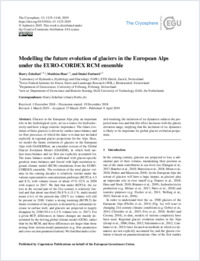Modelling the future evolution of glaciers in the European Alps under the EURO-CORDEX RCM ensemble
- Zekollari, Harry Laboratory of Hydraulics, Hydrology and Glaciology (VAW), ETH Zürich, Switzerland - Swiss Federal Institute for Forest, Snow and Landscape Research (WSL), Birmensdorf, Switzerland - Department of Geoscience and Remote Sensing, Delft University of Technology, Delft, the Netherlands
- Huss, Matthias Laboratory of Hydraulics, Hydrology and Glaciology (VAW), ETH Zürich, Switzerland - Department of Geosciences, University of Fribourg, Switzerland
- Farinotti, Daniel Laboratory of Hydraulics, Hydrology and Glaciology (VAW), ETH Zürich, Switzerland - Swiss Federal Institute for Forest, Snow and Landscape Research (WSL), Birmensdorf, Switzerland
-
09.04.2019
Published in:
- The Cryosphere. - 2019, vol. 13, no. 4, p. 1125–1146
English
Glaciers in the European Alps play an important role in the hydrological cycle, act as a source for hydroelectricity and have a large touristic importance. The future evolution of these glaciers is driven by surface mass balance and ice flow processes, of which the latter is to date not included explicitly in regional glacier projections for the Alps. Here, we model the future evolution of glaciers in the European Alps with GloGEMflow, an extended version of the Global Glacier Evolution Model (GloGEM), in which both surface mass balance and ice flow are explicitly accounted for. The mass balance model is calibrated with glacier-specific geodetic mass balances and forced with high-resolution regional climate model (RCM) simulations from the EURO- CORDEX ensemble. The evolution of the total glacier volume in the coming decades is relatively similar under the various representative concentrations pathways (RCP2.6, 4.5 and 8.5), with volume losses of about 47 %–52 % in 2050 with respect to 2017. We find that under RCP2.6, the ice loss in the second part of the 21st century is relatively limited and that about one-third (36.8 % ± 11.1 %, multi-model mean ±1σ) of the present-day (2017) ice volume will still be present in 2100. Under a strong warming (RCP8.5) the future evolution of the glaciers is dictated by a substantial increase in surface melt, and glaciers are projected to largely disappear by 2100 (94.4±4.4 % volume loss vs. 2017). For a given RCP, differences in future changes are mainly determined by the driving global climate model (GCM), rather than by the RCM, and these differences are larger than those arising from various model parameters (e.g. flow parameters and cross-section parameterisation). We find that under a limited warming, the inclusion of ice dynamics reduces the projected mass loss and that this effect increases with the glacier elevation range, implying that the inclusion of ice dynamics is likely to be important for global glacier evolution projections.
- Faculty
- Faculté des sciences et de médecine
- Department
- Département de Géosciences
- Language
-
- English
- Classification
- Hydrology
- License
-
License undefined
- Identifiers
-
- RERO DOC 324674
- DOI 10.5194/tc-13-1125-2019
- Persistent URL
- https://folia.unifr.ch/unifr/documents/307763
Statistics
Document views: 163
File downloads:
- pdf: 234
